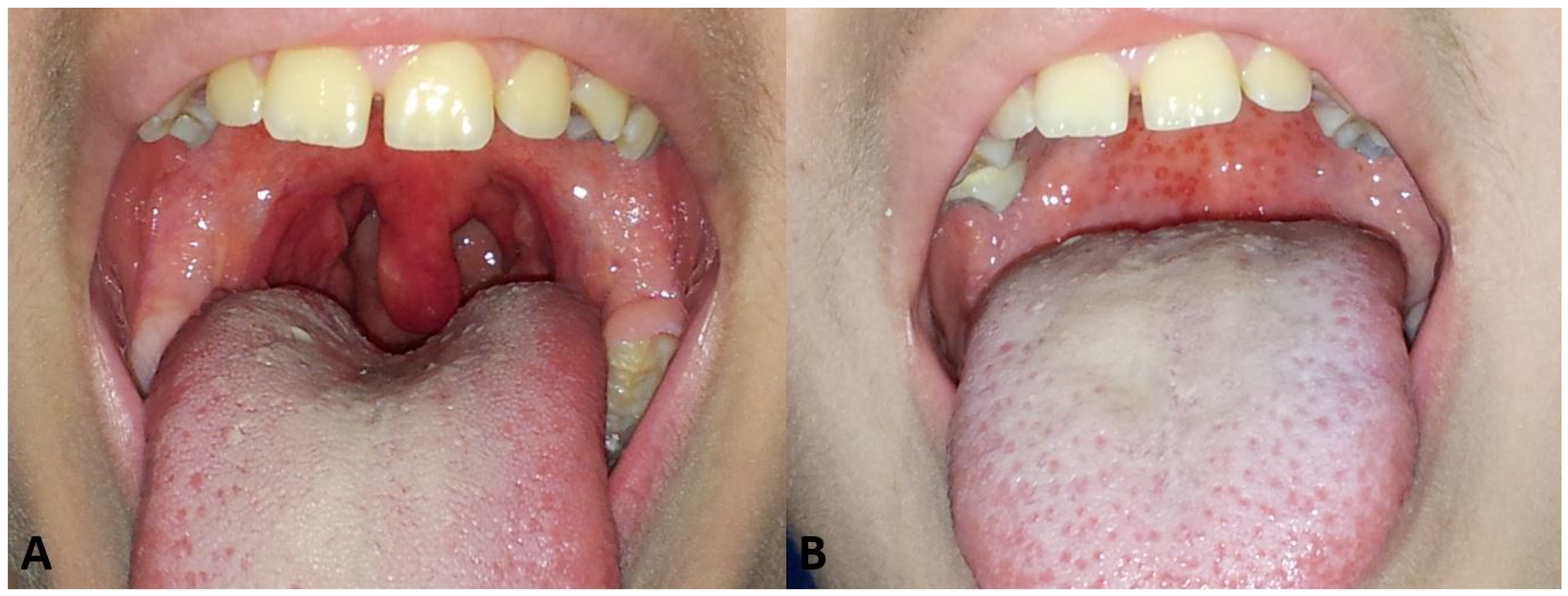“Red Throat” or Acute Pharyngitis—Challenges in Real Life Clinical Practice
Funding
Informed Consent Statement
Conflicts of interest
References
- Boyarchuk, O.; Mochulska, O.; Komorovsky, R. Diagnosis and management of pharyngitis in children: A survey study in Ukraine. Germs. 2021, 11, 363–371. [Google Scholar] [CrossRef] [PubMed]
- Miron, V.D.; Bar, G.; Filimon, C.; Gaidamut, V.A.; Craiu, M. Streptococcal pharyngitis in children: A tertiary pediatric hospital in Bucharest, Romania. J Glob Infect Dis. 2021, 13, 154–155. [Google Scholar] [CrossRef] [PubMed]
- Flood, S.M.; Desai, N.M.; Leonard, J.E.; Mistry, R.D. Emergency department prescribing patterns for pharyngitis in children. Clin Pediatr (Phila). 2020, 59, 995–1003. [Google Scholar] [CrossRef] [PubMed]
- Shapiro, D.J.; Lindgren, C.E.; Neuman, M.I.; Fine, A.M. Viral features and testing for streptococcal pharyngitis. Pediatrics. 2017, 139, e20163403. [Google Scholar] [CrossRef] [PubMed]
- McIsaac, W.J.; Kellner, J.D.; Aufricht, P.; Vanjaka, A.; Low, D.E. Empirical validation of guidelines for the management of pharyngitis in children and adults. JAMA. 2004, 291, 1587–1595. [Google Scholar] [CrossRef] [PubMed]
- Little, P.; Hobbs, F.D.; Moore, M.; et al. PRImary care Streptococcal Management (PRISM) study: In vitro study, diagnostic cohorts and a pragmatic adaptive randomised controlled trial with nested qualitative study and cost-effectiveness study. Health Technol Assess. 2014, 18, vii–xxv, 1–101. [Google Scholar] [CrossRef] [PubMed]
- Martin, J.M.; Green, M.; Barbadora, K.A.; Wald, E.R. Group A streptococci among school-aged children: Clinical characteristics and the carrier state. Pediatrics. 2004, 114, 1212–1219. [Google Scholar] [CrossRef] [PubMed]
- Rick, A.M.; Zaheer, H.A.; Martin, J.M. Clinical features of group a streptococcus in children with pharyngitis: Carriers versus acute infection. Pediatr Infect Dis J. 2020, 39, 483–488. [Google Scholar] [CrossRef] [PubMed]
- Tsuzuki, S. Macrolide resistance in Streptococcus spp. Lancet Infect Dis. Lancet Infect Dis. 2019, 19, 243–244. [Google Scholar] [CrossRef] [PubMed]
- Muhtarova, A.A.; Gergova, R.T.; Mitov, I.G. Distribution of macrolide resistance mechanisms in Bulgarian clinical isolates of Streptococcus pyogenes during the years of 2013-2016. J Glob Antimicrob Resist. 2017, 10, 238–242. [Google Scholar] [CrossRef]
- Lu, B.; Fang, Y.; Fan, Y.; et al. High prevalence of macrolide-resistance and molecular characterization of Streptococcus pyogenes isolates circulating in China from 2009 to 2016. Front Microbiol. 2017, 8, 1052. [Google Scholar] [CrossRef] [PubMed]
- Ubukata, K.; Wajima, T.; Morozumi, M.; et al. Changes in epidemiologic characteristics and antimicrobial resistance of Streptococcus pyogenes isolated over 10 years from Japanese children with pharyngotonsillitis. J Med Microbiol. 2020, 69, 443–450. [Google Scholar] [CrossRef] [PubMed]
- Yu, D.; Zheng, Y.; Yang, Y. Is there emergence of beta-lactam antibiotic-resistant Streptococcus pyogenes in China? Infect Drug Resist. 2020, 13, 2323–2327. [Google Scholar] [CrossRef] [PubMed]
- Miron, V.D. COVID-19 in the pediatric population and parental perceptions. Germs. 2020, 10, 294. [Google Scholar] [CrossRef] [PubMed]

© GERMS 2021.
Share and Cite
Miron, V.D.; Craiu, M. “Red Throat” or Acute Pharyngitis—Challenges in Real Life Clinical Practice. Germs 2021, 11, 351-353. https://doi.org/10.18683/germs.2021.1271
Miron VD, Craiu M. “Red Throat” or Acute Pharyngitis—Challenges in Real Life Clinical Practice. Germs. 2021; 11(3):351-353. https://doi.org/10.18683/germs.2021.1271
Chicago/Turabian StyleMiron, Victor Daniel, and Mihai Craiu. 2021. "“Red Throat” or Acute Pharyngitis—Challenges in Real Life Clinical Practice" Germs 11, no. 3: 351-353. https://doi.org/10.18683/germs.2021.1271
APA StyleMiron, V. D., & Craiu, M. (2021). “Red Throat” or Acute Pharyngitis—Challenges in Real Life Clinical Practice. Germs, 11(3), 351-353. https://doi.org/10.18683/germs.2021.1271



